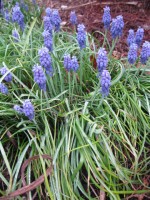 One of the earliest bulbs in my garden to emerge in the spring is grape hyacinth. The dense spikes of fragrant cobalt-blue urn-shaped flowers resemble upside down bunches of grapes and brighten up even the dreariest landscape. They bloom for a long time, naturalize well, are good for forcing, and can be used in borders, rock garden, or as underplantings. They like full sun and well-drained soil but need little else to add beauty to the garden. In the language of flowers grape hyacinths suggest “usefulness” and they certainly are that; since their foliage pops up in the fall they can be used as markers for other bulbs that do not show signs of life until after the garden’s spring clean up. A plant or two of grape hyacinth will remind the eager gardener to avoid the area and give the sleeping bulbs a chance to emerge from the soil without disturbance. That being said, I have to admit that the foliage can be messy looking at times but it disappears as the flower spikes bloom and is less troublesome than the foliage of many other bulbs.
One of the earliest bulbs in my garden to emerge in the spring is grape hyacinth. The dense spikes of fragrant cobalt-blue urn-shaped flowers resemble upside down bunches of grapes and brighten up even the dreariest landscape. They bloom for a long time, naturalize well, are good for forcing, and can be used in borders, rock garden, or as underplantings. They like full sun and well-drained soil but need little else to add beauty to the garden. In the language of flowers grape hyacinths suggest “usefulness” and they certainly are that; since their foliage pops up in the fall they can be used as markers for other bulbs that do not show signs of life until after the garden’s spring clean up. A plant or two of grape hyacinth will remind the eager gardener to avoid the area and give the sleeping bulbs a chance to emerge from the soil without disturbance. That being said, I have to admit that the foliage can be messy looking at times but it disappears as the flower spikes bloom and is less troublesome than the foliage of many other bulbs.
Type: Bulb.
Bloom: Dense clusters of fragrant cobalt-blue urn shaped flowers are borne in spikes in early spring.
Foliage: Grass like ¼” wide leaves emerge in fall and fade in spring.
Size: 6-8” H x 6” W.
Light: Full sun
Soil: Average, well drained.
Hardiness: Zones 4-8
Care: Carefree.
Pests and Diseases: None of significance; somewhat deer-proof.
Propagation: Bulbils.
Companion plants: Azaleas, Johnny jump-ups, narcissus and other spring bulbs.
Outstanding Selections: ‘Blue Spike’ (one of the fullest).
